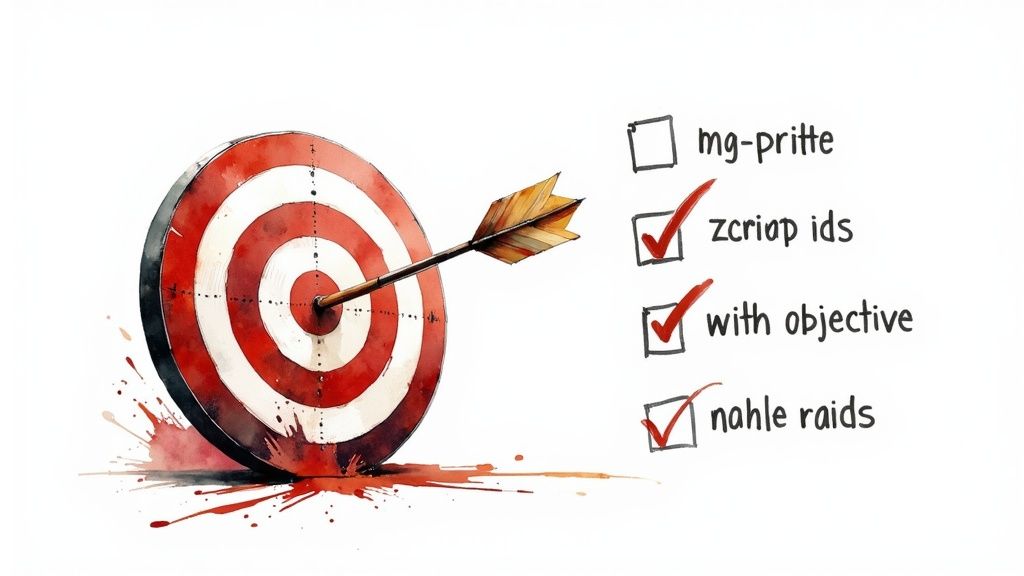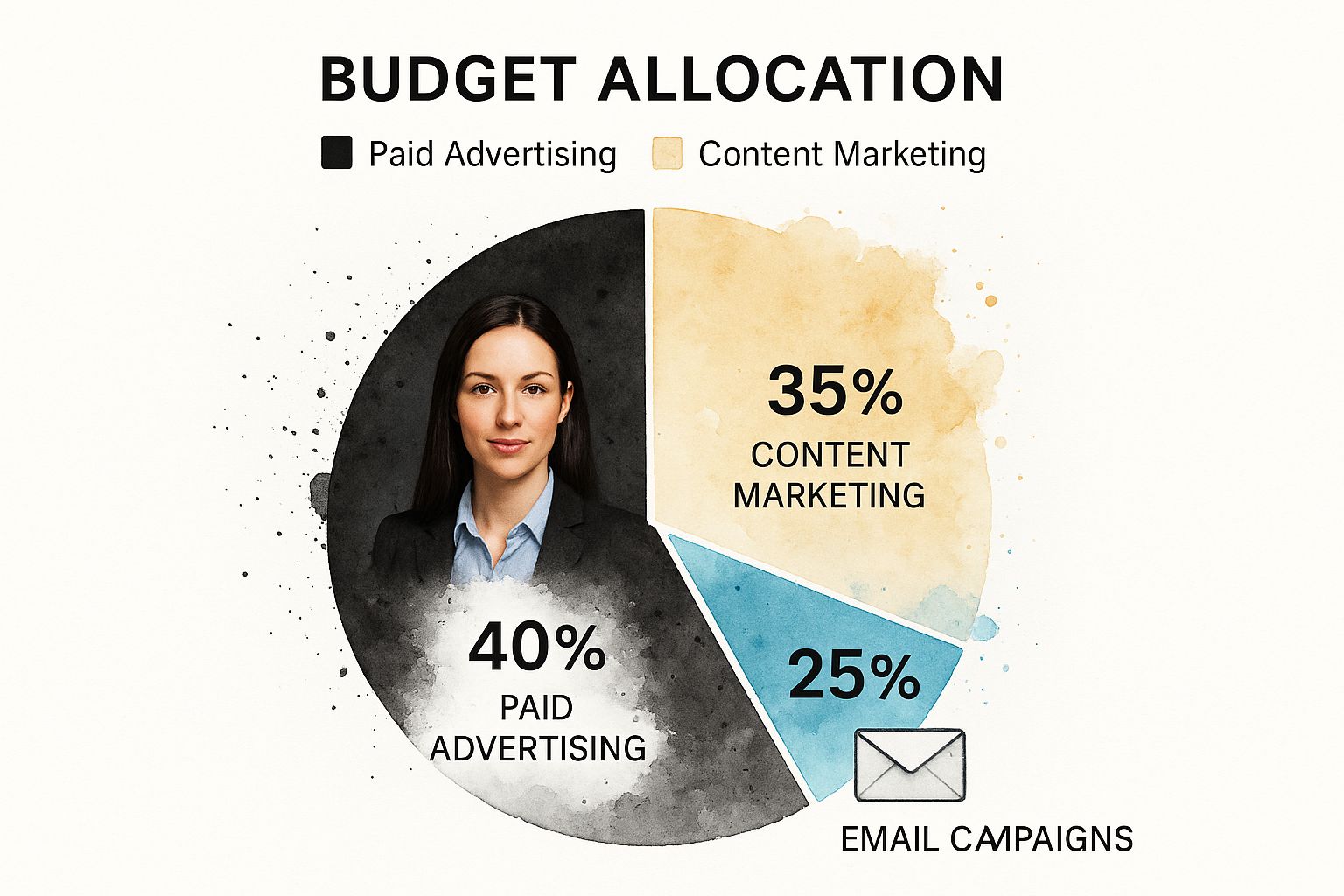A marketing campaign plan template is a strategic document that maps out every critical piece of a marketing initiative—from goals and budget to the target audience and success metrics. Think of it as your blueprint. It turns those big ideas floating around in your head into an actual, actionable roadmap, making sure everyone on your team is on the same page and pulling in the same direction.
Building Your Campaign Beyond the Blank Page

Let's be honest, the most intimidating part of starting a new campaign is staring at that blank page. A solid template gets you past that initial hurdle by providing immediate structure. But this isn't just a fill-in-the-blanks exercise. It's about making deliberate, strategic choices that set you up for a win from day one.
The first move is always to sharpen your focus. You need to go from a vague wish like "grow the business" to a single, powerful goal. A seasoned marketer knows the difference. They'll define a specific objective, something like "increase qualified leads from organic search by 25% in Q3" or "boost customer lifetime value by 15% over the next six months." This kind of clarity is everything.
Defining Your Core Components
Once you have that clear-cut goal, you can start identifying the Key Performance Indicators (KPIs) that will tell you if you're actually making progress. This is where you get specific.
- For Lead Generation: You'll want to track metrics like Cost Per Lead (CPL), landing page conversion rates, and the number of marketing-qualified leads (MQLs) you're generating.
- For Brand Awareness: Keep your eyes on social media reach, website traffic from new users, and how often your brand is being mentioned online.
- For Sales: The big ones here are Return on Ad Spend (ROAS), customer acquisition cost (CAC), and, of course, the total revenue generated by the campaign.
This process ensures every action you take is measurable and directly tied back to that primary objective you set.
A campaign without clear KPIs is like a ship without a rudder. You might be moving, but you have no idea if you're heading in the right direction or just drifting with the current.
To really nail this down, it helps to organize these elements in your template. A simple table can keep everything crystal clear for you and your team.
Essential Components for Your Campaign Plan
This table outlines the core elements every marketing campaign plan template must have to ensure clarity and success.
| Component | What It Covers | Why It's Crucial |
|---|---|---|
| Primary Goal | The single, specific, measurable objective for the campaign (e.g., increase leads by 25%). | Provides a clear "north star" for all campaign activities and decisions. |
| Target Audience | Detailed personas of who you're trying to reach, including demographics and pain points. | Ensures your messaging and channel selection are perfectly aligned with the people you want to attract. |
| Key KPIs | The specific metrics you'll track to measure progress against your goal (e.g., CPL, ROAS). | Makes success measurable and allows you to pivot your strategy based on real data. |
| Budget | The total allocated spend and how it's broken down across different channels and activities. | Provides financial guardrails and forces strategic decisions on where to invest for the best return. |
| Channels | The specific platforms you'll use to execute the campaign (e.g., Google Ads, email, social media). | Focuses your efforts on the platforms where your target audience is most active. |
| Timeline | Key dates and milestones, from campaign launch to the final performance review. | Creates accountability and ensures the entire project stays on schedule. |
Having these components clearly defined from the start transforms your plan from a simple document into a powerful tool for execution and alignment.
Setting a Realistic Budget
Budgeting isn't just about picking a total number; it’s about being strategic with how you allocate it. Let's say you have a hypothetical $50,000 product launch. A smart breakdown might look something like this:
- Paid Search & Social Ads: $20,000 (to capture immediate interest and demand)
- Content Creation & SEO: $15,000 (for building long-term, sustainable assets)
- Influencer Partnerships: $10,000 (to build credibility and tap into new audiences)
- Email Marketing & Automation Tools: $5,000 (for nurturing the leads you generate)
This kind of breakdown forces you to prioritize channels based on your specific goals and audience. For a deep dive into building out just the social media portion of your plan, this social media marketing plan template is a fantastic resource.
And if you're looking for more great marketing insights and strategies, you can find a ton of valuable content on the RebelGrowth blog. By populating your template with this level of detail, you're creating a solid foundation that ensures every dollar spent and every hour worked directly supports your ultimate business goals.
Connecting Your Campaign to Business Goals
 Let's be real: a marketing campaign that exists in a vacuum is a waste of time and money. The most effective campaigns I've ever run weren't just about getting likes or temporary buzz; they were powerful engines driving the company's bigger picture.
Let's be real: a marketing campaign that exists in a vacuum is a waste of time and money. The most effective campaigns I've ever run weren't just about getting likes or temporary buzz; they were powerful engines driving the company's bigger picture.
This is what separates the campaigns that make a real difference from those that are forgotten in a week. Without a clear link to business goals, your efforts have no purpose, and proving your ROI becomes a nightmare.
Your first job is to translate those lofty C-suite objectives into something your marketing team can actually sink their teeth into. Imagine your CEO says the company needs to "increase Q4 revenue by 15%." That's a great North Star, but it’s not a marketing goal. It's on you to break that down.
A much more actionable marketing goal would be something like, "Generate 500 sales-qualified leads (SQLs) from our new product launch campaign to support the 15% revenue growth target." See the difference? Now you have a clear, tangible mission.
Grounding Your Strategy in Reality with a SWOT Analysis
Before you go all-in, you need a reality check. This is where a SWOT analysis becomes your best friend. A common mistake I see is people treating this like a simple checklist they have to tick off. To make it genuinely useful, it has to directly shape your campaign strategy.
Think of it this way. A practical SWOT analysis might uncover insights like these:
- Strengths: We have a massive, engaged email list and incredible customer loyalty.
- Weaknesses: Our organic social media game is weak compared to our top competitors.
- Opportunities: A major competitor just announced they're discontinuing a product that's very similar to the one we're about to launch.
- Threats: New privacy regulations are coming that could mess with our main paid ad channel.
Suddenly, your strategy becomes much smarter. You'd obviously lean hard into promoting the campaign to your email list (your strength). At the same time, you might decide to put some budget behind paid social ads to make up for your organic weakness and, more importantly, to capitalize on that competitor's exit (your opportunity).
A SWOT analysis isn't just an academic exercise; it's a strategic gut-check. It forces you to confront your vulnerabilities and double down on your advantages, making your entire marketing campaign plan template more resilient and effective.
Crafting a Compelling Executive Summary
Once your strategy is solid, you need to sell it internally. The executive summary is your key to getting buy-in from leadership and making sure everyone, from sales to product development, is on the same page. This isn’t a long-winded report; it’s a concise, powerful snapshot of the campaign's mission.
This summary is a critical piece of any good marketing campaign plan template because it forces you to be crystal clear. We all know business objectives can shift, which is why marketing strategy templates are so essential for staying aligned. In fact, something like 70% of marketers have to update their strategies at least once a year just to keep up.
Your executive summary is the condensed version of that strategy, making the entire plan easy for anyone to grasp. Top teams use platforms like Asana to align their marketing strategies for this very reason. When everyone understands their role from the get-go, your campaign has a much greater chance of knocking it out of the park.
Pinpointing Your Audience and Crafting Your Message
 A powerful campaign speaks to a specific someone, not just anyone. Nailing the answer to "Who are we trying to reach?" is what separates campaigns that connect from those that get scrolled past and forgotten. This is a core section of any effective marketing campaign plan template for a very good reason.
A powerful campaign speaks to a specific someone, not just anyone. Nailing the answer to "Who are we trying to reach?" is what separates campaigns that connect from those that get scrolled past and forgotten. This is a core section of any effective marketing campaign plan template for a very good reason.
You have to go beyond the basics. Generic demographic data like age and location is just the first layer. To truly hit home, you need to dig into what makes them tick. What are their real-world frustrations? What gets them motivated enough to look for a solution like yours? Where do they hang out online when they're off the clock?
The answers to these questions are the building blocks of your buyer personas. These aren't just make-believe characters; they're detailed profiles of your ideal customer, pieced together from real data and honest-to-goodness insights. A solid persona makes your audience feel tangible, guiding every creative choice you make.
Developing Your Buyer Persona
To really get a feel for your audience, you have to understand the "why" behind their actions. A good persona moves past simple facts and gets into the nitty-gritty of their mindset and habits.
- Psychographics: This is all about their interests, what they value, and how they live. Are they quick to jump on new tech, or are they more skeptical? Do they prioritize convenience over saving a few bucks?
- Behavioral Data: Take a look at their past purchases and how they act online. How do they engage with brands like yours? Do they prefer to read in-depth blog posts or watch quick video tutorials?
For instance, instead of just targeting "small business owners," you might flesh out a persona for "Startup Sarah." She's a 32-year-old founder, totally swamped by marketing tasks, who tunes into business podcasts on her commute and is active in female entrepreneur groups on LinkedIn. Suddenly, you know exactly who you're talking to and where to find her.
The goal of a buyer persona is to create empathy. When you can step into your customer's shoes and see the world from their perspective, you can craft a message that genuinely speaks to their needs, making them feel seen and understood.
Crafting a Message That Sticks
Once you really get your audience, figuring out your core message becomes a whole lot easier. This message is your unique value proposition—that clear, compelling promise you're making. It has to answer one simple question for your audience: "What's in it for me?"
Let's circle back to "Startup Sarah." A bland message about "marketing solutions" will fly right over her head. She's heard it a thousand times. But, a specific value proposition like, "We help busy founders save 10 hours a week on marketing so you can focus on growing your business," cuts straight to her biggest pain point: not enough time.
This customized approach also dictates your tone and style. For Sarah, you’d use a voice that's empowering, straightforward, and supportive. If your target was a CTO at a huge corporation, your tone would shift to be more formal, data-heavy, and focused on things like security and scale. This is the final, crucial step that turns generic outreach into a real conversation—and ensures your campaign doesn't just get noticed, but gets results.
Alright, you've got your goals set, you know who you're talking to, and you have a budget. Now for the fun part: figuring out how and where you’re actually going to reach people. This is where your marketing campaign plan template shifts from strategy to action. We're talking about picking the right channels and tactics to make your campaign a reality.
The goal isn't just to pick channels; it's to create an integrated mix where everything works together, making the whole campaign stronger than its individual parts.
A classic mistake I see all the time is marketers trying to be everywhere at once. It's a recipe for a diluted message and a drained budget. A much smarter move is to be selective. Pinpoint where your audience actually hangs out and choose the channels that deliver your message most effectively in that context.
For example, if you're launching a visually stunning product for a younger crowd, you'd be crazy not to go all-in on Instagram Reels and TikTok. But if you’re a B2B company trying to get in front of C-suite executives, your time and money are far better spent on LinkedIn and a well-crafted email marketing strategy.
Matching Tactics to Funnel Stages
Different tactics shine at different points in the customer journey. You wouldn’t propose on the first date, right? The same logic applies here. Your plan needs to guide people, not just shout at them.
Awareness Stage: The name of the game is broad reach. Think big. This is where you use tactics like shareable infographics, top-of-funnel blog content that answers common questions, or influencer collaborations to get your brand name in front of fresh eyes.
Consideration Stage: Okay, they know you exist. Now you have to build trust and show them you're the real deal. This is the perfect time for in-depth content like webinars, detailed case studies, and valuable email newsletters. You’re helping them weigh their options, with a gentle nudge toward your solution.
Decision Stage: Time to close the deal. The tactics here need to be direct and action-oriented. We're talking free trials, personalized product demos, and laser-focused sales pages. To see what a world-class conversion-focused page looks like, our guide to effective landing pages is a goldmine for turning casual interest into solid leads.
A smart budget allocation is what makes this multi-stage approach work. You need to invest across the funnel. Here’s a pretty common way to break down a digital campaign budget:

See how this split covers both immediate wins (paid ads) and long-term growth (content and email)? That’s the kind of balance you should be aiming for.
Choosing the Right Channels for Your Campaign
With so many options, how do you actually choose? It comes down to your specific goals and audience. I've found a simple framework can really help cut through the noise and make deliberate, effective choices.
Here’s a practical comparison to help you select the most effective channels based on your campaign goals and audience.
| Marketing Channel Selection Framework | |||
|---|---|---|---|
| Channel | Best For (Goal) | Audience Fit | Key Metrics |
| SEO/Content | Building long-term authority, organic lead gen | Users actively searching for solutions | Organic Traffic, Keyword Rankings, Conversions |
| PPC (Google/Bing) | Capturing high-intent searchers, driving immediate sales | Users with a clear need, ready to buy | CTR, Cost Per Conversion, ROAS |
| Social Media Ads | Building awareness, precise demographic targeting | Specific interests, behaviors, and demographics | Reach, Engagement Rate, Cost Per Lead |
| Email Marketing | Nurturing leads, customer retention, direct sales | Your existing audience and warm leads | Open Rate, Click-Through Rate, Conversion Rate |
| Video (YouTube/TikTok) | Demonstrating products, brand storytelling, engagement | Visual learners, younger demographics | View-Through Rate, Watch Time, Subscribers |
This table isn't exhaustive, but it's a solid starting point. The key is to look at this and think, "Which of these align most closely with what I need to achieve and who I need to reach?"
Creating a Cohesive Channel Mix
Here's where the real magic happens. Your channels shouldn't be islands. A truly great campaign makes them work in concert. Your social media drives sign-ups for your email list. Your email list promotes your newest blog post. Your blog post has a call-to-action for a product demo. It becomes a seamless, self-reinforcing loop.
The best marketing campaigns feel like a unified conversation happening across multiple platforms, not a series of disconnected ads. Each channel should build upon the last, guiding the customer smoothly toward your goal.
Take email marketing, for example. It's an absolute powerhouse for nurturing leads you've gathered from other places, boasting an insane average ROI of around $36 for every $1 spent. To get results like that, you have to do it right. As you build out your plan, it’s worth brushing up on some actionable email marketing tips to make sure you're effectively engaging people once they're in your ecosystem.
By carefully picking your channels and mapping out specific tactics for each funnel stage, your marketing campaign plan template transforms from a document into a roadmap. It’s a framework that ensures your resources are spent wisely, your impact is maximized, and your campaign is far greater than the sum of its parts.
Measuring Success and Adapting on the Fly
A great marketing plan isn't something you create, frame, and hang on the wall. Think of it more as a living, breathing guide. It’s meant to evolve as you start gathering real-world data from your campaigns.
The most successful marketing I've seen is always agile. It’s built around a constant feedback loop: measure performance, figure out what the numbers really mean, and tweak your approach based on those insights. This whole process actually kicks off before you even spend your first dollar.
Getting your tracking and analytics set up from day one is completely non-negotiable. This means your Google Analytics goals need to be configured, your UTM parameters should be standardized across the team, and all your social media pixels must be firing correctly. Without this foundation, you’re basically flying blind, with no real way to connect your actions to your results.
Identifying Metrics That Truly Matter
Once the data starts to trickle in, the real challenge is filtering out the noise. It’s so easy to get caught up in vanity metrics—things like social media likes or a ton of impressions. They might give you a nice ego boost, but they rarely translate to actual business impact.
Instead, you need to zero in on the metrics that tie directly back to the goals you laid out in your marketing campaign plan template.
- Is your goal lead generation? Then you should be obsessing over your Cost Per Lead (CPL), landing page conversion rates, and the number of truly qualified leads you're handing off to sales.
- Are you focused on driving sales? In that case, Return on Ad Spend (ROAS), Customer Acquisition Cost (CAC), and the total revenue driven by the campaign should be your north star metrics.
For a channel like email, this kind of tracking is especially critical. To get a clear picture of how your emails are performing, you need something more robust than a basic dashboard. Using a high-quality email metrics report template can help you dig into the data and pull out actionable insights. It forces you to look past simple open rates and focus on the click-throughs and conversions that actually move the needle.
A marketing plan without real-time measurement is just a list of expensive assumptions. The data tells you what's working, what's failing, and where your next dollar should be spent for maximum impact.
Making Smart Decisions Mid-Campaign
This data-first approach is what allows you to make intelligent pivots while the campaign is still running.
Let's say you see your Instagram ads are bringing in leads at a $15 CPL. At the same time, your LinkedIn ads are costing you $75 CPL for the same quality of lead. The decision here is a no-brainer. You can immediately shift budget away from LinkedIn and double down on what’s clearly working on Instagram.
This agile method is quickly becoming the standard for a reason. In fact, about 80% of marketers report seeing higher customer engagement when they use AI and data to personalize their campaigns. What’s more, businesses using AI-enhanced templates have seen engagement and conversion rates jump by up to 30%.
Ultimately, treating your marketing plan as a flexible blueprint empowers you to react to the market in real time. This not only dramatically improves your current campaign's bottom line but also teaches you invaluable lessons that will make your next one even more successful.
Common Questions About Marketing Campaign Plans
Even the best marketing campaign plan template can spark a few questions. Let's tackle some of the most common ones we hear from marketers who are ready to put their plans into action.
Getting these details right is what separates a document that gathers dust from one that actually drives growth. Think of this as the final gut-check before you launch.
How Often Should I Update My Marketing Campaign Plan?
Your campaign plan should be a living document, not something you carve in stone. While the core strategy and goals might be set for the campaign's duration, you have to be agile with the day-to-day execution.
I recommend a weekly or, at the very least, bi-weekly check-in on your performance metrics. This is your chance to make smart adjustments on the fly, like shifting budget away from an underperforming ad set or tweaking your messaging based on what’s actually resonating.
Waiting until the campaign is over to see what happened is a massive missed opportunity. The real learning happens in the trenches.
What Is the Difference Between a Marketing Plan and a Campaign Plan?
This is a crucial distinction, and one that trips a lot of people up.
Think of it like this: your overall marketing plan is the world map. It’s your long-term strategy, usually covering a full year. It outlines broad business objectives, brand positioning, and the major marketing pillars you'll focus on—like SEO, content marketing, and paid acquisition.
A marketing campaign plan, on the other hand, is the detailed itinerary for a single trip. It’s a focused, time-bound project within that larger plan. It zeroes in on a single, primary goal, like a new product launch, a seasonal promotion, or a lead generation push for a specific service.
How Do I Create a Campaign Plan on a Small Budget?
A small budget forces you to be ruthless with your focus. This is a good thing. Instead of trying to be everywhere, you have to pick the one or two channels where your target audience is most active and truly engaged. It's all about prioritizing low-cost, high-impact tactics.
Some great places to start include: * Organic Social Media: Forget posting ten times a day. Focus on creating one or two incredibly valuable pieces of content that you can repurpose across different formats and platforms. * Content Marketing: Write one amazing, in-depth blog post that solves a major pain point for your audience. Make it the definitive resource on that topic. * Email Marketing: Nurture the list you already have. It's consistently one of the most cost-effective channels out there, period.
A tight budget isn't a dead end—it's a constraint that breeds creativity. It forces you to get laser-focused on what really moves the needle.
The single most important part of any campaign plan is tying your campaign goal to a specific business objective. Without that connection, your efforts are just noise. A campaign to "get more followers" is a vanity project; a campaign to "increase qualified leads by 20%" is a business driver.
Finding the right tools can also stretch a small budget. To find software and services that fit your needs without breaking the bank, check out the marketing tools available in the RebelGrowth directory.
Ready to stop guessing and start growing? RebelGrowth provides the AI-powered tools and insights you need to build winning marketing strategies, create high-ranking content, and drive measurable results. Get started and build your next successful campaign with us. https://rebelgrowth.com
